Bus Stop Urban Design 
Introduction |
Literature Review |
7 Goals |
9 Techniques |
Selection |
9 Designs |
Bibliography
4.0 Bus Stop Urban Design Techniques
The Bus Stop Urban Design Techniques are a set of parameters for the design of many aspects of a transit stop in hope of achieving the goals set out in the previous section. Each goal is supplemented with past research and precedents. The 9 techniques address: lighting, seating, cover, amenities, information, vegetation, traffic management, pedestrian infrastructure, and bicycle infrastructure.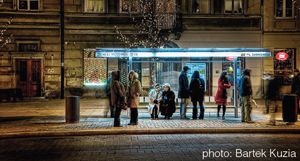
4.1 Lighting
Even, white light with minimal shadows provides the best environment for activities and enhances safety. Pedestrian scale lighting adds to the character of the location.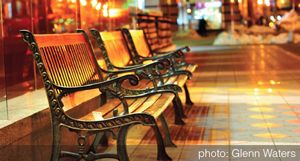
4.2 Seating and Surfaces
Adequate seating with a variety of microclimatic conditions is important for comfort and allows riders to adapt to their preferences. Special paving can denote pedestrian priority.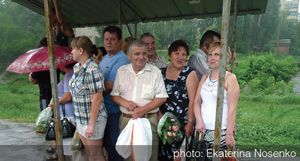
4.3 Cover
Cover provides primary weather protection from precipitation and excessive solar exposure. Where possible, cover may be achieved by adjacent awnings or vegetation.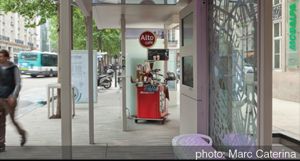
4.4 Amenities
Amenities such as public art, drinking fountains, and waste bins not only improve the experience of the transit user, but they also benefit the immediate neighbourhood.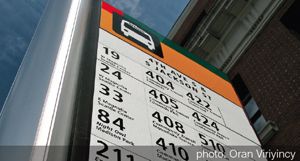
4.5 Information
Transit information provided at a stop can greatly reduce rider anxiety in waiting. Extra space may be dedicated to displaying community information if the stop is a high traffic area.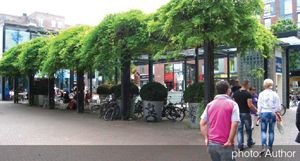
4.6 Vegetation
Vegetation can manage the microclimate of a stop by providing shade, cover, and wind blocks. It can also be used to enhance the aesthetics of the location.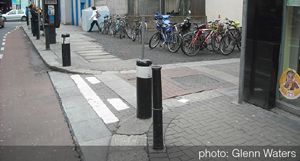
4.7 Traffic Management
Traffic management techniques focus on reducing vehicular speeds around transit stops and making biking and walking in the area safer and more pleasant.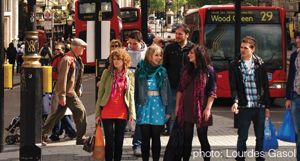
4.8 Pedestrian Infrastructure
The pedestrian network around a stop is an extension of the transit line. Therefore, it is important to have high quality walking environments to attract new riders.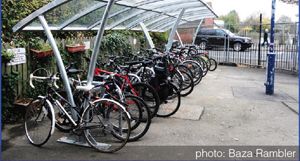
4.9 Bicycle Infrastructure
Many residents would bike to transit stops if it were more convenient. To encourage such behaviour, adequate bike paths and bike parking must be provided.4.1 Lighting
4.1.1 Lighting and Safety
Lighting at a transit stop is important for safety, access, and character. Studies show that commuters who identified safety as their primary concern also named lighting to be the most effective solution (Hess, 2012). As most public crimes are triggered by windows of opportunity (Saraiva & Pinho, 2011), it is important to keep areas around stops adequately lit at night as well other times of the day. Even lighting throughout the stop, rather than spot-lighting, provides an ambient environment with lower contrast shadows. This condition is desired as commuters feel safer in areas that have visual and spatial permeability because all activity at the site can be easily observed (J. Jacobs, 1961; Saraiva & Pinho, 2011).4.1.2 Lighting and Character
In terms of character, pedestrian scale lighting does a better job of creating a comfortable environment for the commuter and is more likely to fit with the surroundings than standard street lights. Pedestrian scale lighting refers to lights that are lower, smaller and usually more visually interesting (Hamilton-Baillie & Jones, 2005). Lower lights that are less intense and spaced closer together offer more even and comfortable lighting for pedestrians (A. B. Jacobs, 1995). A survey in Japan identified that lighting spaced at 30 metre intervals had the most pedestrian benefit to cost ratio (Fukahori & Kubota, 2003). The lights may be integrated with the transit shelter, be integrated with other pieces of furniture at the stop, or be stand-alone. Choosing lighting styles that complement the architectural style of adjacent developments can enhance the visual coherence and attractiveness of the setting (Kostic & Djokic, 2009). Such improvements can be beneficial, as studies show a correlation between a commuter's subjective measures of a stop and their frequency of use of the stop (Carr, Dunsiger, & Marcus, 2010).4.2 Seating and Surfaces
Seating is one of the most fundamental components of a transit stop. Whether for a bus stop, the amount of seating should match the average number of commuters simultaneously occupying the stop, given that it does not impede access (Tan et al., 2007). Being able to sit while waiting for transit and being able to put down any heavy belongings significantly reduces the stress experienced by the commuter (Buys & Miller, 2011). As a result, the disutility of waiting at the stop can be reduced, making transit a more pleasurable experience (Wardman, 2004). This chain effect can ultimately lead to an increased catchment area and ridership as studies show that people are willing to walk farther to stations if they know the waiting environment is comfortable (Jiang, Christopher Zegras, & Mehndiratta, 2012).Because materials of the urban environment play an important roles in modifying the microclimate and thermal comfort conditions, it is important to consider the albedo, reflectivity, and other thermal attributes of the seats in order to avoid unnecessary heat gain or glare (Asaeda & Thanh, 1996). However, having seating does not guarantee a successful transit stop. Many well-used stops have a variety of seating options. This diversity gives the commuter more freedom of choice and will better serve people of different physical attributes, social habits, and in different weather conditions (Schmidt, Nemeth, & Botsford, 2011). It is not required that all seating for a transit stop be provided and maintained by one entity. With cooperation between designers and developers, between commuters and neighbours, the best case scenario would be seating that is seamlessly integrated with, or created from the surrounding urban landscape. When this is the case, it beneficial to have the seating on the peripheyl of the site, as it is the preferred configuration by most people (Gehl, 1987). Such seats should be able to serve non-commuters during non-rush hours and be sufficiently shielded from vehicular traffic.
4.3 Cover
Cover refers to anything that offers weather protection as a transit stop, which includes precipitation, wind, and excessive solar exposure (Nikolopoulou et al., 2011). Weather protection is a prime contributor to commuter comfort (Humpel et al., 2004). Surveys show ideal temperatures to be around 24 degrees Celsius, acceptable range for wind is between 3 and 5.5m/s, and acceptable range for noise is between 40 and 70 decibels (Chun & Tamura, 2005; Giddings et al., 2011). With clever design and the right materials, it may be possible to achieve all year comfort passively.There are many ways of achieving weather protection at a transit stop, with sheltering being the primary component. While it is often cheaper to standardize shelters across the city, shelters should ideally be fitted to the microclimate of the site (Schmidt et al., 2011). Possible techniques range from wrap-around designs, which offer the most protection, to open designs, which encourage natural ventilation. The albedo, reflectivity, and other thermal attributes should also be considered in order to avoid unnecessary heat gain or glare (Asaeda & Thanh, 1996). If the transit stop is located near tall buildings, it is important to have structures that buffer the downwash, such as awnings or a veranda (Gaardsted Esbensen Consulting Engineers Ltd., 2004). Fences can also serve as wind block in open areas. Studies show that fences with 35% to 40% opening provide the best wind buffer while maintaining visual permeability and not generating too much turbulence elsewhere (Nikolopoulou, 2004). Orientation of the shelter is also a key consideration given the solar and prevailing wind directions (Chrisomallidou et al., 2004). In all instances where insulation is desired, it is important to make sure design features do not inadvertently cause leaks. Wherever possible, the design of the stop should strive to take advantage of the physical forms adjacent to it, such as large awnings of businesses to minimize costs (Steemers, Ramos, & Sinou, 2004). The end goal is to create a diversity of microclimates at the stop so that even if the conditions are not ideal, people will have to opportunity to choose different environments or engage in adaptive behaviour (Schmidt et al., 2011).
4.4 Amenities
Amenities refer to objects at the transit stop that enhance the experience of waiting but are not absolutely necessary. Examples of amenities include waste bins, newspaper boxes, public art, and public phones (York Regional Transit, 2009). Other design-oriented amenities such a signs, lights, and canopies contribute to the sense of place in a public space (A. B. Jacobs, 1995). Aside from their intended uses, they also act as objects that attract the visual attention of the commuters, thereby reducing boredom that may result from long wait times (Compagnon & Goyette-Pernot, 2004). When deciding on amenities, it is important to take into account adjacent land uses and programming. Well used amenities are ones that suit the needs of the neighbourhood. Stops beside daycares may include playful public art; stops beside grocery stores may include extra shelves for people to rest their goods while waiting for the bus. Because the effect of these amenities can extend to roughly 15 meters beyond the station, one should consider the possibility that non-commuters may also use these amenities (Learnihan, Van Niel, Giles-Corti, & Knuiman, 2011). Design and placement of these amenities should not cause any obstructions, thereby lowering the level of service for pedestrians and cyclists (Tan et al., 2007). Large amenities, such as community bulletin boards not only provide relevant information, but they also provide shading, wind protection, and acoustic separation (Chrisomallidou et al., 2004; Kang et al., 2004). Therefore, it is important to consider microclimatic conditions of the site when placing amenities so as to extract maximum benefit from the investment.4.5 Information
Information plays an important role in the performance of a transit stop. Ideally, schedule information will be presented both in real time and in static form (Wardman et al., 2001). While arrival information is best suited for digital display, transit maps are best presented in print form, especially for those without smart devices. A variety of media ensure that the information is accessible to everyone. If the transit station becomes a natural place of gathering for the immediate neighbourhood, community information should also be incorporated into the station displays where possible. Community organizations would benefit from the assured pedestrian traffic flow to generate exposure for their messages (Zacharias et al., 2011). Other information that is less common but would be valuable are pedestrian, cycling, and green infrastructure maps for the specific neighbourhood (Kelly, Tight, Hodgson, & Page, 2010). Contextual variations such as this have been shown the increase the sense of ownership of a public space (Ercoskun & Karaaslan, 2011). For stops in less densely populated areas, it is sometimes beneficial to have way-finding signs that direct the commuter towards the stop. By labelling the remaining distance to the stop, such signage are helpful to seniors who many plan their stop choice based on the walking time required (Hess, 2012).4.6 Vegetation
Vegetation has long been avoided at transit stops because they were seen as a safety hazard for blocking sightlines and limiting circulation space (Eck & McGee, 2008). However, with careful design and plant selection, vegetation and related natural features, such as flowing water, are being reintroduced to the public spaces around transit for their aesthetic and functional values (Kleerekoper et al., 2011). Studies show that vegetation can make a positive contribution to almost every comfort aspect of a transit station. Vegetation contributes to the visual attractiveness of a transit stop. Using a visual preferences survey, Ewing found that almost all commuters prefer trees along the path leading to the stop over treeless paths (Ewing, 2001). Planting can also be used to define pedestrian spaces and create a sense of security and it shields pedestrians from heavy traffic, physically, visually, and acoustically. In fact, surveys show that the presence of vegetation is found to affect 65% of the population in their decisions to cross streets (Sisiopiku & Akin, 2003).4.6.1 Microclimate
With an average albedo of 0.2 to 0.25, vegetation also mitigates the local microclimate by reducing air temperatures, shading, and providing wind protection (Dimoudi & Nikolopoulou, 2003). Studies show that trees and hedges can reduce the surrounding air temperature by 1 to 3 degrees Celsius due to reduced solar gains (-20% to -60%), reduced convective heat gain, and the addition of moisture to the air (Dimoudi & Nikolopoulou, 2003; Kleerekoper et al., 2011). Unlike fixed, solid objects, vegetation is also excellent for wind breaking as they slow down wind without creating much turbulence or greater wind speed elsewhere (Gaardsted Esbensen Consulting Engineers Ltd., 2004). Studies show that on average, vegetation can reduce wind speeds by around 20% (Dimoudi & Nikolopoulou, 2003). Placement of plants must be considered because both their thermal and wind blocking effects can be felt for up to 4-5 times the height of the plant belt away from vegetation (Houlberg, 1979). Vegetation has also been proven effective in noise mitigation in public spaces as they are able to block sound waves without causing multiple reflections (Yang & Kang, 2003). It is important to note that microclimatic effect of vegetation ultimately depends on its type and growth; mature trees have foliage temperatures below ambient air temperature, while the opposite is true for young trees (Scudo et al., 2004). Deciduous trees work well in fairer climates as it provides shading in the summer and permits solar exposure in the winter; evergreens provide shading and wind breaks all year round (Chrisomallidou et al., 2004). Insufficient foliage may result in little or even opposite effects (Scudo et al., 2004).4.6.2 Community
Because of the pedestrian exposure transit stops are guaranteed to receive, it is a great location to test and demonstrate new ecology-based systems (Ercoskun & Karaaslan, 2011). Bio-swales and green walls are excellent candidates for such locations and serve as didactic tools while contributing to the overall function of the stop. In some cities in the Netherlands, community interaction is taken further as neighbours volunteer to take care of the vegetation (Kleerekoper et al., 2011). On a larger scale, it is important for the site vegetation to be integrated with neighbourhood green infrastructure if opportunities exist (Walmsley, 1995).4.7 Traffic Management
There are many traffic management techniques that can be used to the make the area surrounding transit stops safer for commuters. Most of these strategies go against traditional conventions in traffic engineering by focusing on reducing the speed of vehicles that are in close proximity to pedestrians to around 30 kph (Hamilton-Baillie, 2004; Hamilton-Baillie & Jones, 2005; Kaparias et al., 2012). When traffic is slowed to such speeds, risk of fatal accidents is significantly lowered and pedestrians no longer feel the need to be pushed to the margins of the street (Gallimore et al., 2011; Rosén & Sander, 2009). Traffic calming elements such as chokers, raised crosswalks, bicycle bypasses are already popular in many major European cities (Ewing, 2008). More options are available in many engineering publications (Cho et al., 2009). Where traffic cannot be slowed down, physical separation and crossing lights greatly increase the comfort of pedestrians (Tan et al., 2007). Trees and shrubs lower than 6 meters are recommended because they not only provide visual and acoustic separation, but they also add to the attractiveness and contribute to the thermal comfort of the setting (Fukahori & Kubota, 2003).4.8 Pedestrian Infrastructure
4.8.1 Measuring Walkability
Several indices and audits have been developed to measure the walkability of an environment. They look at elements such as the street wall, sidewalk width, amenities, and many more. Three well known publications are the Irvine-Minnesota Physical Environment Audit (Brown et al., 2007), the Scottish Walkability Assessment Tool (Millington et al., 2009), and the Illustrated Field Manual for Measuring Urban Design Qualities (Clemente, Ewing, Handy, & Brownson, 2010).4.8.2 Enhancing Quality
Elements of a good walking environment include wide sidewalks, shaded corridors, sufficient lighting, interesting streets, land use diversity, natural features, and other pedestrians (Brown et al., 2007; Cao, Mokhtarian, & Handy, 2008; Jiang et al., 2012; Saraiva & Pinho, 2011). Where pedestrian paths are in close proximity with other modes, it is important to denote their presence clearly to drivers through separation, paving materials, or other design methods (Kaparias et al., 2012). As a further measure, traffic calming techniques should be employed where pedestrian flows are high (Susilo et al., 2012). Such actions will increase the comfort and confidence of commuters. Focusing on the pedestrian path itself, studies show that pedestrian comfort increments with sidewalk width gradually (Tan et al., 2007). Well maintained walking surfaces are also a key determining factor for those with greater difficulty walking (Borst et al., 2008). Therefore, it is crucial to provide a sufficient level of service for the expected pedestrian flow (Mori & Tsukaguchi, 1987).4.8.3 Increasing connectivity
Walking time is consistently valued at around 1.5 to 2 times higher than the time spent in vehicle. Therefore, to promote walking to transit stops, the walking path must be more comfortable and perceptually shorter. It is shown that neighbourhoods with greater density of intersections correlates with higher walking rates (Ewing & Cervero, 2010). This is because pedestrians are given a greater range of choice of routes and have more direct paths to their locations. Therefore, strategies for increasing connectivity of the pedestrian network include placing cross walks to break up long blocks, connecting sidewalks with the local trails, and formalizing shortcuts so that the shortest route can also be comfortable and safe (Learnihan et al., 2011).4.9 Bicycle Infrastructure
4.9.1 Station Level Accommodations
Cycling is substantially faster than walking and more flexible than driving in regard to travelling to a transit stop (Martens, 2004). Many transit agencies around the world have already implemented bike parking in various forms, ranging from individual bike racks to purpose-built bike storage buildings. A recent survey of bicycle parking programs in North America showed that most transit agencies have experienced dramatic increases in the use of bike parking, ranging from increase of 50% to 80% from 2000 to 2005 (Transportation Research Board, 2005). We can see that the demand for such facilities is increasing steadily.Bicycle parking should be provided to match the minimum expected ridership. Ideally, the design of the parking system would be able to accommodate expansions in the future. When possible, it is beneficial to include other professionals such as industrial designers, artists and engineers to ensure that parking facilities not only function well but also adds to the visual intrigue of the environment (Kashef, 2008). Bicycle parking can also be integrated with and used as a of traffic calming measure (Ewing, 2008). With multiple modes accessing the transit stop, it is important that bicycle traffic and parking are compatible with pedestrian flow and other amenities (Transportation Research Board, 2005).
4.9.2 Increasing connectivity
Analysis should be conducted layering the existing bicycle network with the transit network to find where vital connections can be made and where new routes should be established. The latter step will benefit greatly from on-site observation and interview with local riders. By providing adequate bicycle parking at transit stops and ensuring cycling connectivity around stops, transit agencies can significantly strengthen the economic performance of lines by increasing the catchment area and alleviating the stress involved in accessing transit (Martens, 2004).BSUD Project Map
2.1 Urban Realm and Transit Ridership
2.2 Urban Realm and Active Transportation
2.3 Physical Activity and Health